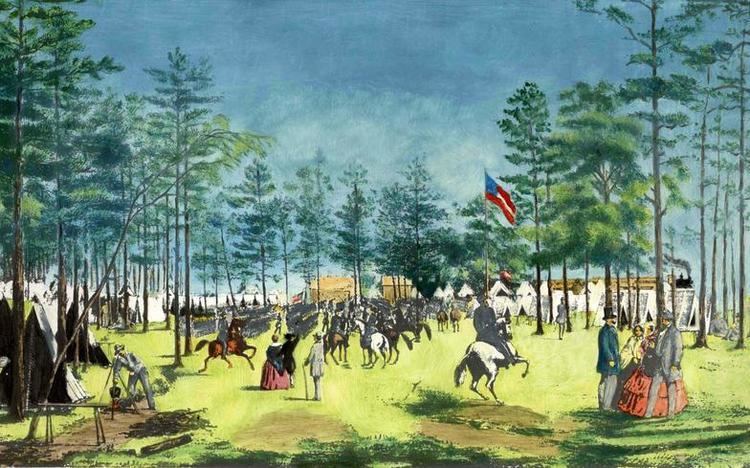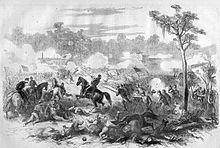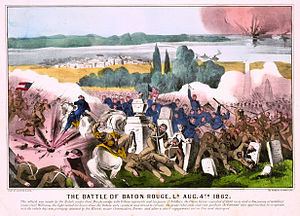2,500 2,600 | Date 5 August 1862 | |
 | ||
371 killed, wounded and missing 478 killed, wounded and missing Similar American Civil War, Siege of Port Hudson, Capture of New Orleans, Battle of Fort Bisland, Battle of Plains Store | ||
Battle of baton rouge 1862
The Battle of Baton Rouge was a ground and naval battle in the American Civil War fought in East Baton Rouge Parish, Louisiana, on August 5, 1862. The Union victory halted Confederate attempts to recapture the capital city of Louisiana.
Contents
- Battle of baton rouge 1862
- Battle of baton rouge reenactment story
- Background
- Battle
- Union Army
- Confederate Army
- Confederate Navy
- References

Battle of baton rouge reenactment story
Background

On April 25, 1862, the day before New Orleans fell to the U.S. Navy fleet under Admiral David Farragut, the Confederate state government decided to abandon Baton Rouge, moving first to Opelousas, and then to Shreveport. All cotton in the area was set afire to prevent it falling into Union hands. On May 9, Navy Commander James S. Palmer of the federal gunboat USS Iroquois landed at the town wharf and took possession, without resistance, of the Pentagon Barracks and the arsenal. Two weeks later, a party of guerrillas attacked a rowboat carrying a naval officer. In retaliation, Farragut's flagship, the Hartford, bombarded the town, causing civilian casualties and damaging St. Joseph's Church and other buildings. On May 29, U.S. Brigadier General Thomas Williams arrived with six regiments of infantry, two artillery batteries, and a troop of cavalry, and began the occupation of Baton Rouge.

During the summer, Major General Earl Van Dorn, commander of Confederate forces east of the Mississippi, resisted a Union bombardment of Vicksburg. The Confederate ironclad ram Arkansas had come down the Yazoo River, inflicting damage on the unprepared Union fleet as she passed through, and was anchored in Vicksburg. Van Dorn desired to regain Baton Rouge. It was thought that re-taking Baton Rouge would be key to driving the Union out of Louisiana, as they could then launch attacks along the Red River on Union occupied territory as well as threaten Union control of New Orleans.

5,000 men entrained from Vicksburg for Camp Moore, led by Maj. Gen. John C. Breckinridge, on July 27, 1862. They were joined by a small infantry division led by Brig. Gen. Daniel Ruggles at the camp. Simultaneously, the Arkansas was sailing down the Mississippi River, on her way to engage the Union ships near Baton Rouge. The men had a significant amount of equipment or supplies, and were well fed. General Williams reportedly had word of the forces' departure from Camp Moore on July 28. On August 4, after information was again received of the imminent arrival of the enemy, Union troops were formed up a mile out of Baton Rouge. However the Union men at Baton Rouge were not experienced and were in training camp for only two weeks before being sent to Baton Rouge. The troops had few supplies because most were in New Orleans, which was considered more important.
Battle
Breckinridge moved to the Comite River, 10 miles (16 km) east of Baton Rouge, by August 4, and then marched the men closer at night. The Confederates lost the element of surprise when they were discovered by Union sentries. Despite this, the attack was launched at daybreak on August 5.
The Union troops were in the center of Baton Rouge, while the Confederates were lined up in two divisions, north of the city. The action occurred around Florida Street, and began with the Confederates pushing their opponents all the way across town. Bitter fighting took place, especially around Magnolia Cemetery. The Union commander, Brigadier General Thomas Williams, was killed in action. Colonel Thomas W. Cahill took over.
The colonel led a retreat back to prepared defensive lines near the Penitentiary, under the protection of the Union warships. The Confederate troops began coming under fire from the gunboats. The Confederate ram Arkansas arrived not long after but her engines failed just four miles above the city. Her commander ordered her set afire to prevent her capture. Without any prospect of naval support, Breckenridge was unable to attack the Union positions and withdrew. Union troops evacuated the city a week later, concerned for the safety of New Orleans, but returned that autumn. Confederates occupied Port Hudson, which they held for almost another year.
The "Battle of Baton Rouge Commemorative Ceremony" is held every year on the first Saturday in August in and around Magnolia Cemetery, sponsored by the Foundation for Historical Louisiana.
Union Army
2nd Brigade, Department of the Gulf)
Brig Gen Thomas Williams (killed)Col Thomas W. CahillInfantry Regiments
Artillery
Union Navy
Confederate Army
Breckinridge's Corps
Maj Gen John C. BreckinridgeInfantry Regiments
Artillery
